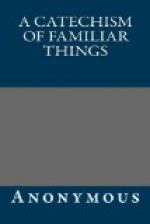Preservative, a preventive of decay.
What is Musk?
A dry, friable substance of a dark color, taken from a little bag under the belly of a small animal called the Thibet Musk, which is a native of the Indies, Tonquin, and China. It inhabits the woods and forests, where the natives hunt it down. Musk is so strong a perfume as to be agreeable only in the smallest quantities, or when mingled with some other scent; it is used in perfumery, &c.
Is there not another Animal which produces a similar scent?
Yes; an animal of Arabian origin produces an odoriferous substance called Civet, from which it takes its name of Civet Cat; there are several species of this animal which produce it, but it is from the Civet Cat that it is most commonly taken. Civets are found in all the warm parts of Asia and Africa, in Madagascar, and the East Indian Islands. It was formerly in high esteem, but is at present very little used, except to increase the power of other perfumes.
What is Myrrh?
A kind of gum-resin, issuing from the trunk of a tree growing in Arabia, Egypt, and Abyssinia; it flows either naturally, or by incision; and is sent to us in small lumps of a reddish brown or yellow color. Its smell is strong, but not disagreeable. Our myrrh is the same drug that was used by the ancients under the above name. Its chief use now is in medicine. The ancient Egyptians employed it as an ingredient in the embalming of dead bodies.
Embalming, preserving
the bodies of the dead from decaying
or putrefying, by impregnating
them with aromatics and other
substances which resist
putrefaction.
Where is Abyssinia?
Abyssinia is a large kingdom situated in Eastern Africa.
What is Frankincense?
An odoriferous, aromatic gum-resin, which distils, in the heat of summer, from incisions made in the bark of the tree which produces it: notwithstanding the great use of the gum, both in ancient systems of religious worship and in modern medicine, authors have been much divided in opinion with regard to the kind of tree from which it is obtained; it is a species of turpentine tree belonging to an order of resinous and fragrant trees and shrubs inhabiting the tropical parts of the world.
For what was it formerly used?
The ancients burnt it in their temples as a perfume, and to do honor to the divinities that were worshipped in them: it appears to have been applied to the same purposes by people of all religions. Myrrh and Frankincense were reckoned by the Eastern nations amongst their most costly perfumes. We are informed by St. Matthew’s Gospel in the New Testament, that the wise men who came to Bethlehem to worship our Saviour at his birth, brought gifts of gold, frankincense, and myrrh. Many of the primitive Christians were put to death because they would not offer incense to idols. In the Catholic Church we still retain its use in many ceremonies.




